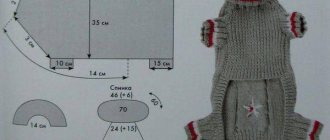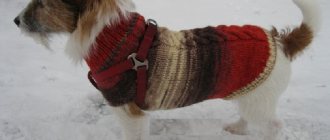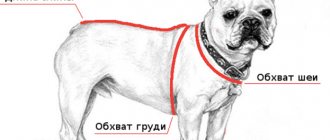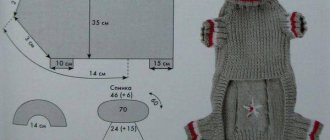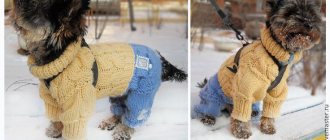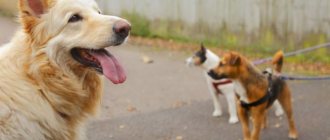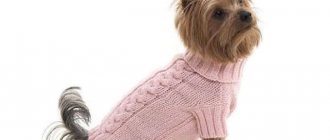Not all dogs tolerate cold and damp weather well; many pets are at risk of catching a cold and getting sick. Owners of small dogs of decorative breeds especially often face such problems. Therefore, it is very important to dress your pet according to the weather. In this material we knit clothes for any breed and size of dog with our own hands using master classes with diagrams and photos.
Clothing for pets can be crocheted or knitted. Crocheted items, when knitted tightly, are quite warm and hold their shape perfectly. If you knit with knitting needles, the clothes will be more elastic, but also looser.
Pros and cons of knitted clothes
For dog owners who are familiar with knitting needles and also know how and love to knit, knitting a warm item for the cold season for their pet is a pleasure. Let's list the advantages of hand-made knitted clothes:
- Hand-knitted clothes are always fashionable.
- This will cost much less than store-bought pet clothing.
- No need to run around the shops looking for the right size, color, style.
- Knitted clothes will be made in a single copy.
- The clothes will be tailored exactly to size, that is, made to order: the chosen model, knitting pattern, length of the product, accessories - everything will satisfy exactly your wishes.
- From one skein of yarn you can knit not only a sweater or blouse, but also other accessories (hat, beret, scarf).
- In this outfit, your pet will stand out among others.
There are also disadvantages, but they are few and can be easily eliminated:
- Hand-knitted wool products stretch over time. This is very easy to fix by adding a simple thread to the knitting or buying yarn with a small percentage of artificial fiber.
- When worn and washed, “pillings” form on clothes. But they can be easily removed using a safety razor or a special device.
So, there are some advantages, it’s time to start choosing yarn.
We recommend this article:
What to buy and how to make clothes for a pug with your own hands
We knit clothes for dogs with our own hands in step-by-step lessons
Symbols in diagrams:
- air loop - air loop
- st/s/n – double crochet
- st/b/n – single crochet
- connect/st – connecting column (half single crochet)
- n. - loop
This sweater is very easy to knit with your own hands, it is easy to put on and fastens with a button at the neck of the belly strap.
To work you will need:
- Basic yarn: about 200-250 g for a small dog.
- A small amount of yarn in a contrasting shade for edging.
- Hook number 6 or 6.5.
- Large button approximately 2.5 cm in diameter.
If the dog is large, you can change the size of the sweater by adding rows (1 row of sc/b/n is approximately equal to 8mm). You can also reduce the size. Be sure to try on the sweater as you go!
We knit a sweater collar.
We cast on 23 in/p, knit the 1st row with st/b/n from the 2nd loop from the hook. At the end of the row, VP and move to the 2nd row. Up to the 50th row inclusive we continue to knit st/b/n. Then st/b/n behind the back wall, in/p, at the end the thread is not secured.
Leaving the hook in the last loop, we combine the first and last rows with half-columns. In this way we connect all the rows, closing the collar. At the end of 2nd stitch, do not fasten the thread.
We knit the main part of the sweater.
Along the rim of the collar we knit 48 sts/s/n, leaving the remaining columns of the collar free. We knit 2 single rises and move to the next row. Up to the 22nd row we continue to knit the same st/s/n. Here, if necessary, you can add rows, increasing the size. In the next row we make a decrease to the required amount, knitting st/s/n through one loop. We knit a few more rows and secure the thread.
We knit a sweater strap.
We knit from the end of the 15th row from the collar along the edge of the product 13 st/s/n. We start each next row with 2 high rises. Starting from the 21st row, we make a hole for the button, skipping st/s/n and knitting in/c. It's better to make 2 holes. In the last row we knit st/s/n without gaps.
We knit a finishing row along the edge of the product, including the untied part of the collar.
At the level of the 15th row from the collar, sew on a button.
Selection of yarn and tools
A visual list of what you will need for knitting:
- yarn. Yarn should be chosen according to desire and capabilities. The range of yarn is very wide and varied;
- hook or knitting needles (preferably circular, on fishing line or knitting needles for knitting socks). These tools are selected depending on the thickness of the thread. The label of a skein of yarn indicates the number of knitting needles corresponding to the specific thread article;
- scissors, needle and sewing thread to sew finished parts;
- accessories (buttons, zipper, hooks, buttons, rivets, etc.).
We recommend this article:
DIY knitting pattern for warm clothes for Chihuahuas
We make a stylish knitted costume for dogs of any breed
The suit will be useful for small dogs in winter to prevent hypothermia and frostbite.
A large collar can be added if desired by knitting it.
Here is a universal pattern that is suitable for a pet of any breed. The main thing is to decide on the sizes. To do this, you need to measure the length of the dog’s back as carefully as possible, then divide the resulting figure by 8. You need to measure from the collar to the tail. This will be the length of the side of the square along which you need to draw a pattern, as in the photo:
For a length of 31 cm you need about 150 g of yarn, knit with double thread crochet number 3.
We start knitting in st/b/n with a collar of the required height. We leave the third part for the chest and then knit the back with double crochets in a “braid” pattern or another dense pattern. The patterns for this pattern look like this:
Then we crochet the breast. As you knit all the elements, you need to attach the product to the pattern.
Next we knit the sleeves. It is better to knit the elastic band with knitting needles, so it will be more elastic. It is not necessary to knit a cowl collar, but it is advisable, since the pet’s ears are also very sensitive to cold. You can also tie a lining to the fur coat, if necessary.
Crochet sweater for little fashionistas
Gone are the days when a dog in a sweater caused confusion among passers-by on the street. Clothing for dogs is sold in every, even the smallest pet store, and even more so on the Internet you can find everything your heart desires. Therefore, choosing a high-quality and suitable outfit for your pet will not be difficult. But real craftswomen know that for your beloved dog there is nothing better than a sweater that fits perfectly, knitted by hand. The article presents patterns and descriptions of crocheting a sweater for a dog. Size S, i.e. The length of the animal's back is 25 cm.
Taking measurements for knitting
Sweater for a dog: how to knit for beginners
This is the most responsible process. The appearance of the finished clothing and how it will fit on the dog depend on correctly measured volumes and lengths. If the dog is very active, it is problematic to cope alone, it is better to turn to someone for help.
Basic measurements you will need when knitting dog clothes:
- chest girth. Measured at the widest part of the chest;
- neck girth. On the contrary, they measure in the narrowest place;
- back length. Measure from the beginning of the neck to the tip of the tail;
- paw length Measure from the armpit to the ground. The parameter is useful for products with sleeves or panties;
- paw girth The parameter is measured at the widest part of the limbs;
- distance between paws. This size is important when knitting overalls.
To take measurements correctly, you need to use the table
How to knit a blanket and beret for a dog in a master class
We knit in multi-colored stripes, alternating 2 rows of each color (orange, blue and light blue).
We cast on 42 v/p with blue yarn and knit st/b/n 24 cm, changing the color of the threads. We close the middle 15 stitches and knit both parts separately for another 34 cm, then close. Along the neckline we cast on loops and knit st/b/n 6 cm. On the sides of the blanket, at a distance of 11 cm from the start of work, cast on 10 stitches and tie strips of st/b/n 10 cm long with blue thread. Sew buttons or Velcro onto the edges of the strips . We make multi-colored fringes along the perimeter of the blanket. We tie the collar and fasteners in a “crawfish step” with blue yarn. Along the edges of the blanket at the base of the collar, tie 35 chain strings.
Beret: Using a blue thread we knit a chain of 4 v/p., close it in a circle and knit in a circle st/b/n, alternating colors (the width of the strip is 3 rows) and adding 8 sts in each row. After 12 rows, start decreasing . After 4 rows we close all the loops and tie the edge with a crawfish step. Sew a pompom to the beret.
Variety of warm clothes
Clothes for dogs can be casual or formal. There are many types of clothing:
- overalls;
- blanket;
- sweater or jumper;
- dress;
- panties.
A knitted suit will give your pet a unique appearance.
For your information! The easiest product to make is a cape. To knit it you do not need to have perfect technique. These clothes are suitable for cool spring or autumn. In winter, more thorough insulation is still required in the form of overalls or a set of pants and a jacket for a dog.
In addition to basic clothing, hats of various styles and dog shoes are popular among animals.
Yorkie feels cozy and warm in a knitted hat
When choosing a model, you should pay attention not only to beauty, but also to practicality:
- the ties must be of sufficient length so that they do not come undone during walks;
- clothing should not hinder the pet’s movements;
- the collar should fit freely under or on top of the product;
- The length of the sleeves and panties should be shortened, otherwise the lower edges will quickly wear out.
Video: How to crochet a skirt to a jacket?
You can also read master classes on crocheting and knitting a variety of products on our portal:
- Knitting clothes for small dogs;
- Tunisian crochet;
- Crochet and knitting lessons for beginners;
- Crocheting a beret with knitting needles for beginners;
- Crochet socks.
Dedicated to needlewomen who confidently hold knitting needles and hooks in their hands.
You can create a unique wardrobe for your pet by creating a range of knitted clothes for your toy terrier with your own hands. Knitted clothes differ favorably from sewn and purchased ones in that, firstly, they are very warm, and secondly, they are ideal for freezing small dogs that lack protection in the form of a thick undercoat.
Features of sewing winter overalls
Both the first and second options can be made for winter. It is insulated using a fleece lining, fleece and synthetic fillers (sintepon, holofiber). The lining is cut and sewn in the same way as the main part, and then both parts are carefully sewn together from the wrong side.
You can sew the top with lining in several places (along the chest, waist or across) so that the jumpsuit fits well and does not “fidget” in different directions. In the winter version, the sleeves, neckline and tail cutout must be placed on soft elastic cuffs so that they fit more closely to the animal’s body.
The item can be decorated with fur, buttons, rhinestones and appliqués. Make sure that the animal cannot reach the decorative elements, bite off and swallow them.
Comfortable boots for dogs
This part of the master class with a description will help needlewomen learn how to knit boots for their pets.
Knitted shoes for dogs are very comfortable to wear, as they do not rub anywhere.
In order for the product to last longer, you should listen to our advice:
- Sew a thick insole from the inside of the boot;
- Make the sole from impermeable, rough fabric. Make the remaining parts with knitting needles, picking up loops along the edge of the sole;
- To prevent the claws from resting on the toe of the boot, cover it with a strip of leather or nylon;
- You can use any style of knitting, but remember that the loops should not be airy, and the threads should be strong and dense. Thanks to such shoes, the dog's paws will always be warm, and he will never get sick!
Article on the topic: Openwork elastic with knitting needles: description with diagrams, photos and videos
